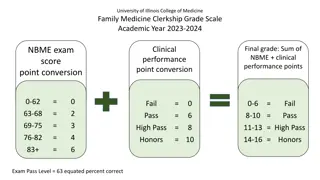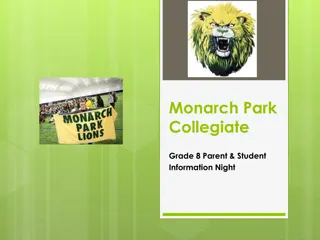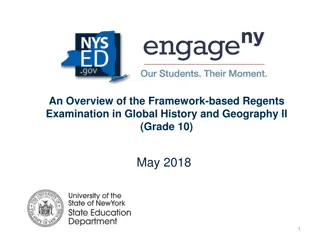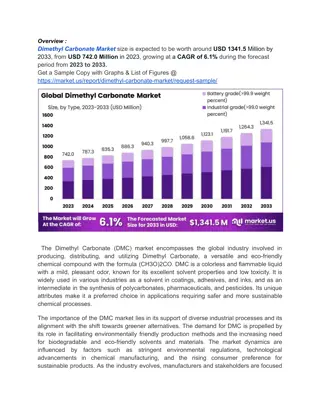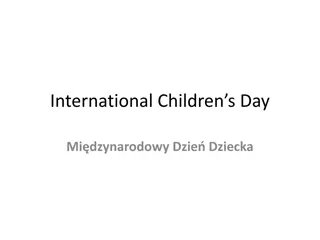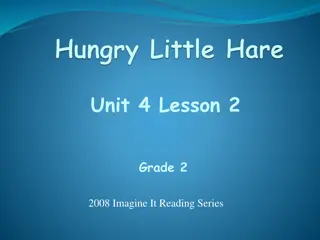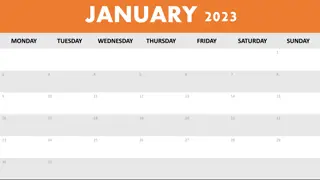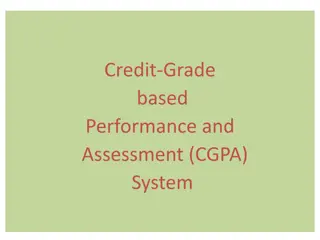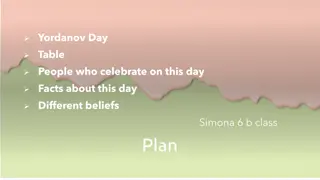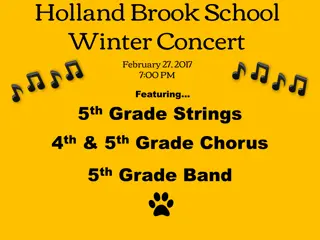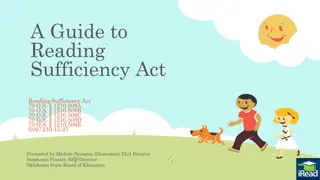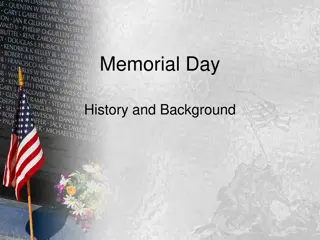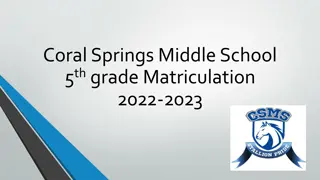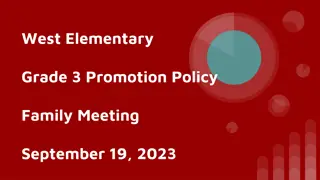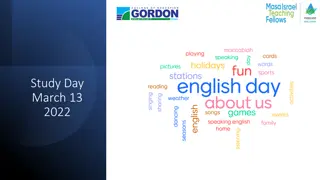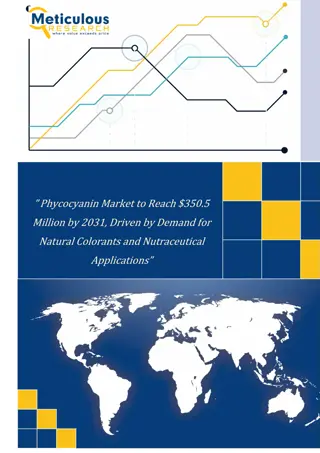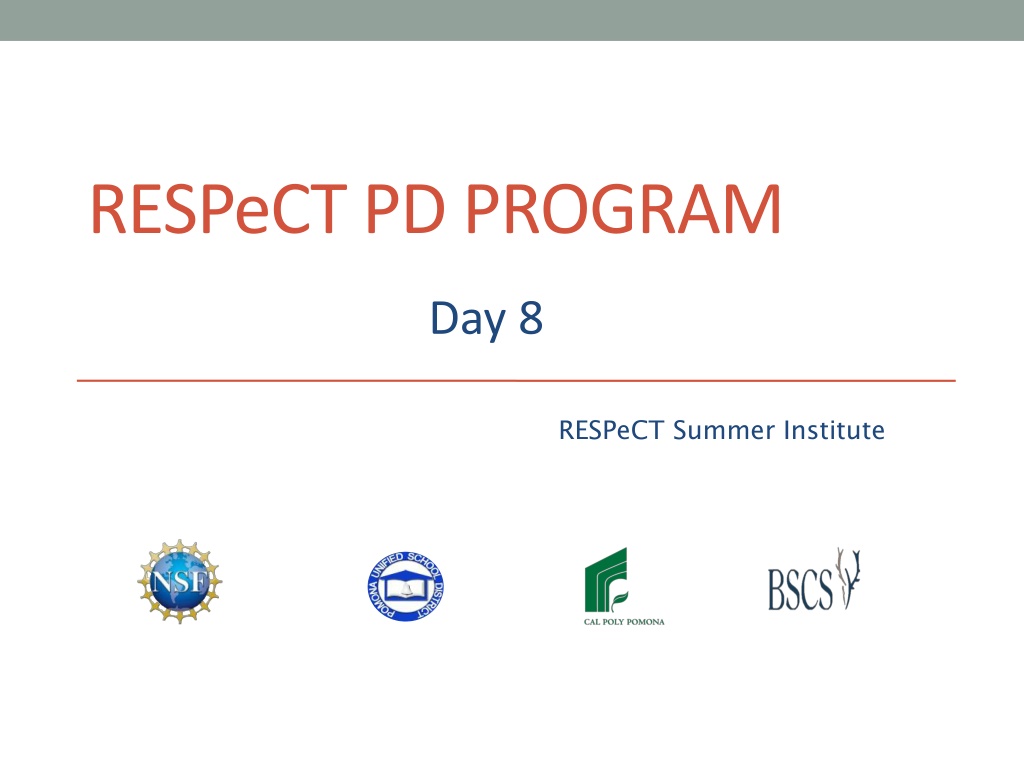
Enhancing Science Content Coherence with SCSL Strategies
Explore how to enhance science content coherence through the explicit implementation of STeLLA strategies F, G, and H. Discover the key features and importance of strategies in improving the storyline coherence of science lessons. Dive into reflections, lesson analysis, and focus questions to prepare for teaching SEC lessons in the future.
Download Presentation

Please find below an Image/Link to download the presentation.
The content on the website is provided AS IS for your information and personal use only. It may not be sold, licensed, or shared on other websites without obtaining consent from the author. Download presentation by click this link. If you encounter any issues during the download, it is possible that the publisher has removed the file from their server.
E N D
Presentation Transcript
RESPeCTPD PROGRAM Day 8 RESPeCT Summer Institute
Agenda for Day 8 Day-7 reflections Focus questions Introducing SCSL strategies F, G, and H Lesson analysis: SCSL strategies F, G, and H SEC Lesson plan review Fall overview and study-group scheduling Lunch Content deepening: the Sun s effect on climate Wrap-up and celebration!
Trends in Reflections Lesson Analysis Science Content Learning
Todays Focus Questions How can science content storyline coherence be enhanced by explicitly implementing STeLLA strategy F (Make explicit links between science ideas and activities), strategy G (Link science ideas to other science ideas), and strategy H (Highlight key science ideas and focus question throughout)? How will the Student Thinking Lens and Science Content Storyline Lens strategies help you teach the SEC lessons in the fall? Approximately how large and far from Earth would the Sun need to be in a scale model in which a marble represents Earth? What objects could most accurately represent the Sun and Earth in a scale model in which Earth s orbit fit just inside your classroom? Why is an inaccurate Earth-Sun model used in SEC lesson 3?
Lesson Analysis: Focus Question 1 How can science content storyline coherence be enhanced by explicitly implementing STeLLA strategy F (Make explicit links between science ideas and activities), strategy G (Link science ideas to other science ideas), and strategy H (Highlight key science ideas and focus question throughout)?
SCSL Strategies F, G, and H: Purposes and Key Features Group 1: What are the purposes and key features of strategy F? Why is this strategy important for science content storyline coherence? Group 2: What are the purposes and key features of strategy G? Why is this strategy important for science content storyline coherence? Group 3: What are the purpose and key features of strategy H? Why is this strategy important for science content storyline coherence?
SCSL Strategies F, G, and H: Discussion Question What s similar and different about these three strategies?
Preparing for Video-based Lesson Analysis Read Analysis Guide F, part 1. 1. What is the difference between the main learning goal and supporting science ideas? 2. What is similar about the main learning goal and supporting science ideas?
Lesson Analysis: Strategy F 1. For each of the video clips, read the context at the top of the transcript and then watch the clip: Video clips 1 and 2: setup for the activity Video clip 3: during the activity Video clip 4: follow-up to the activity 2. For each clip, use the criteria in part 2 of Analysis Guide F to analyze how well science ideas were linked to the activity. Links to Anderson video clips 1 4: 8.1_stella_SEC_anderson_c2; 8.2_stella_SEC_anderson_c3; 8.3_stella_SEC_anderson_c4; 8.4_stella_SEC_anderson_c5
Lesson Analysis: Strategies F, G, and H Strategy F: a. Find examples in the video transcripts where students are linking science ideas to a lesson activity. b. Suggest one specific way to strengthen strategy F in this lesson. Strategy G: a. Find examples where two or more science ideas are being linked together. b. Suggest one specific way to strengthen strategy G in this lesson. Strategy H: a. Find an example where the teacher is highlighting key science ideas or referring back to the focus question. b. Suggest one specific way to strengthen strategy H in this lesson.
Summary: Strategies F, G, and H Use linking strategies to make the science ideas explicit to the whole class (strategies F and G). Engage students in linking science ideas to activities before, during, and after an activity (strategy F). Engage students in linking science ideas to other science ideas (strategy G). Highlight key science ideas throughout the lesson (strategy H). Keep returning to the focus question throughout and at the end of the lesson (strategy H).
Lesson Analysis: Focus Question 2 How will the Student Thinking Lens and Science Content Storyline Lens strategies help you teach the SEC lessons in the fall?
SEC Lesson Plan Conversation 1. The science content storyline across lessons Review the main learning goal for each lesson sequentially. 2. The science content storyline within lessons (5 7 min for each two-part lesson) How does this lesson fit into the arc of all the lessons? What are the main learning goal and focus question? Describe the main activity (or activities). How will the activity help students better understand the learning goal for the day? What STeLLA strategy/strategies are highlighted in this activity? What concerns or suggestions do you have about this activity? 3. Practical issues and questions
STL Strategies Highlighted in the SEC Lessons 1a 1b 2a 2b 3a 3b 4a 4b 5a 5b 6a 6b 7a 7b Lesson 1. Elicit 2. Probe 3. Challenge 4. Analyze/ Interpret 5. Explain/ Argue 6. Use/Apply 7. Synthesize/ Summarize
SCSL Strategies Highlighted in the SEC Lessons Lesson 1a 1b 2a 2b 3a 3b 4a 4b 5a 5b 6a 6b 7a 7b A. Identify Main Learning Goal B. Set Purpose and Focus Question C. Match Activity to MLG D. Match Content Reps to MLG F. Link Activity to Science Ideas G. Link Science Ideas H. Highlight Key Science Ideas and Focus Question I. Summarize Key Science Ideas
Overview of Study-Group Sessions 1. Purpose: To practice, analyze, and learn from the use of the STeLLA strategies in your science teaching. 2. Review the focus of each study-group session: What is the main focus for fall study-group sessions 1 3? What is the purpose of the 2-hour meeting in December/January? What is the main focus for spring study-group sessions 4 6?
Teaching the Suns Effect on Climate Lessons 1. Before teaching lesson 1, give your students the classroom pretest. 2. Teach all the lessons and have one lesson video recorded. 3. Give your students the classroom posttest. 4. Hold on to your students pre-post tests! You ll analyze them in preparation for Study Group 3.
Scheduling School-Year Study Groups Proposed meeting day/time: Wednesdays 2:00 6:00 p.m. Meeting place: In our classrooms, rotating from school to school Possible dates for our study-group sessions: Study Group 1: [insert possible date] Study Group 2: [insert possible date] Study Group 3: [insert possible date] 2-hour meeting to review Genetics lessons: [insert possible date] Study Group 4: [insert possible date] Study Group 5: [insert possible date] Study Group 6: [insert possible date]
THE SUNS EFFECT ON CLIMATE MATH CONTENT DEEPENING Grade 6
Content Deepening Focus Questions Approximately how large and far from Earth would the Sun need to be in a scale model in which a marble represents Earth? What objects could mostaccurately represent the Sun and Earth in a scale model in which Earth s orbit fit just inside your classroom? Why is an inaccurate Earth-Sun model used in SEC lesson 3?
Content Deepening: Focus Question 1 Approximately how large and far from Earth would the Sun need to be in a scale model in which a marble represents Earth? Image courtesy of NASA, Visible Earth Project
Activity 1: A Sense of Scale Object Approximate Distance from Center of Earth (km) Closest Power of 10 Approximate Size (km) Closest Power of 10 150,000,000 ? Diameter: 1,392,000 ? Sun Diameter: 12,756 ? Earth 384,000 ? Diameter: 3,500 ? Moon Depth: 11 ? Mariana Trench Elevation: 8.9 ? Mount Everest
Activity 1: Rounding to Powers of 10 Object Approximate Distance from Center of Earth (km) Closest Power of 10 Approximate Size (km) Closest Power of 10 150,000,000 108 Diameter: 1,392,000 106 Sun Diameter: 12,756 104 Earth 384,000 105 Diameter: 3,500 103 Moon Depth: 11 10 Mariana Trench Elevation: 8.9 10 Mount Everest
Activity 1: Ratios and Proportion Fill in the blanks: The diameter of the Sun is about _______ times larger than the diameter of Earth. The distance from the Sun to Earth is about _______ times larger than the diameter of the Sun.
Activity 1: Summary The ratio of the diameter of the Sun to the diameter of Earth is about 106:104, which is equivalent as a ratio to 102:1. The diameter of the Sun is about 102 = 100 times larger than the diameter of Earth. The ratio of the distance from the Sun to Earth to the diameter of the Sun is about 108:106, which is equivalent to 102:1. The distance from the Sun to Earth is about 102 = 100 times larger than the diameter of the Sun.
Activity 2: Earth-Marble Model The diameter of a marble is about 1 cm. Approximatelyhow large and far from Earth would the Sun need to be in a scale model in which a marble represents Earth?
Activity 2: Summary The diameter of a marble is about 1 cm. Approximatelyhow large and far from Earth would the Sun need to be in a scale model in which a marble represents Earth? In a scale model, if Earth were a marble (with a 1 cm diameter), the Sun would be a boulder (with a diameter of about 100 x 1 cm = 1 m) at a distance of about 100 x 1 m = 100 m from Earth.
Activity 3: Experience the Scale! To experience the scale of the Earth-Sun system, let s head outside and create a scale model. Bring your science notebooks and pens with you.
Activity 3: The Power of Powers of 10 Scientists use powers of 10 to quickly and easily track the difference in scale between various elements of a system so they can determine which features are relevant and which are not. Estimating large numbers by powers of 10 makes it easy to compute ratios and compare large numbers, but we sacrifice accuracy for convenience.
Activity 4: A Scale Model of the Solar System Courtesy of Alex Gorosh and Wylie Overstreet Link to video clip: https://vimeo.com/139407849
Reflect: Content Deepening Focus Question 1 Approximately how large and far from Earth would the Sun need to be in a scale model in which a marble represents Earth? How do you know? Image courtesy of NASA, Visible Earth Project
Content Deepening: Focus Question 2 What objects could most accurately represent the Sun and Earth in a scale model in which Earth s orbit fit just inside your classroom?
Activity 5: A Model Sun Earth s orbit: If the shortest dimension of the classroom is 8 m across, then an orbit with a 4 m radius would just fit in the classroom. Earth-Sun distance: This distance needs to be about 100 times larger than the diameter of the model Sun. Sun diameter: If 100 model Suns placed side by side total 4 m, then each model Sun should have a diameter of 4 cm (100 x 4 cm = 400 cm = 4 m). Key point: For Earth s orbit to fit your classroom, you d need something like a small appliance lightbulb to represent the Sun.
Activity 5: Working with Ratios and Unknowns For a 4-meter-radius classroom orbit, the diameter of the model Sun (in meters) is an unknown D. Model Sun Diameter Model Orbit Radius Actual Sun Diameter Actual Orbit Radius to to D m : 4 m 1 Sun : 100 Suns D/4 : 1 1/100 : 1 Correct scale requires equal ratios, so D/4 = 1/100 (D = 0.04 m or 4 cm) Remember: For Earth s orbit to fit in your classroom, you d need something like a small appliance lightbulb to represent the Sun.
Activity 5: A Model Earth Now let s focus on identifying an object that could mostaccurately represent Earth in a scale model. If the shortest dimension of a classroom is 8 m across, then a small appliance lightbulb about 4 cm in diameter could represent the Sun. What object could most accurately represent Earth?
Reflect: Content Deepening Focus Question 2 What objects could mostaccurately represent the Sun and Earth in a scale model in which Earth s orbit fit just inside your classroom? How did you figure it out?
Content Deepening: Focus Question 3 Why is an inaccurate Earth-Sun model used in SEC lesson 3?
Lesson 3: The Earth-Sun Model Components: An incandescent lightbulb (representing the Sun) A Hula Hoop (representing Earth s orbit) A Styrofoam ball on a stand (representing Earth tilted on its axis) A rubber band around the center of the ball (representing the equator) An image of the North Star (posted on a wall near the ceiling)
The North Star Fun fact: Astronomers estimate that the North Star is about 3 x 1015 km away from the Sun. Remember: Earth is about 108 km away from the Sun. Question: How far away from your model Sun (lightbulb) would you have to place the North Star image for the classroom model to be accurate?
The Accuracy of the Earth-Sun Model Accurate Inaccurate Features of Model
The Accuracy of the Earth-Sun Model Accurate Inaccurate The model Sun emits light. The orbital path (Hula Hoop) is circular. The model Earth is tilted on its axis (using the stand). The North Star is positioned above the orbital plane. The North Star is more than 10 billion times closer than it should be. The orbit (Hula Hoop) is more than 10 times smaller than it should be. The model Earth is more than 100 times larger than it should be. The model Earth doesn t rotate on its axis (neither does the Sun). Features of Model Why use an inaccurate, out-of-scale model in lesson 3?
Benefits of Using an Inaccurate Model Main learning goal for lesson 3: Earth s consistent tilt produces opposite seasons in the Northern and Southern Hemispheres. Ways the Earth-Sun model matches this goal: Exaggerating Earth s size helps students see how the Sun illuminates different parts of Earth and relate this to the Northern and Southern Hemispheres. A smaller orbit using the Hula Hoop enables students to move Earth around the Sun more easily. Maintaining Earth s consistent tilt toward the North Star throughout its orbit enables students to better visualize how sunlight striking the surface in different positions causes opposite seasons in the Northern and Southern Hemispheres.
Reflect: Content Deepening Focus Question 3 Why is an inaccurate Earth-Sun model used in SEC lesson 3?
Todays Focus Questions How can science content storyline coherence be enhanced by explicitly implementing STeLLA strategy F (Make explicit links between science ideas and activities), strategy G (Link science ideas to other science ideas), and strategy H (Highlight key science ideas and focus question throughout)? How will the Student Thinking Lens and Science Content Storyline Lens strategies help you teach the SEC lessons in the fall? Approximately how large and far from Earth would the Sun need to be in a scale model in which a marble represents Earth? What objects could most accurately represent the Sun and Earth in a scale model in which Earth s orbit fit just inside your classroom? Why is an inaccurate Earth-Sun model used in SEC lesson 3?
Summarizing Science Content Storyline Lens Strategies What does the organization of the summary chart in the STeLLA strategies booklet highlight about the Science Content Storyline Lens strategies? Do you want to make any revisions or additions to our chart on effective science teaching?
Lets Celebrate! Design your own end-of-program celebration and insert any comments or instructions here.
Thank You! Thank you for participating in the RESPeCT PD program!



